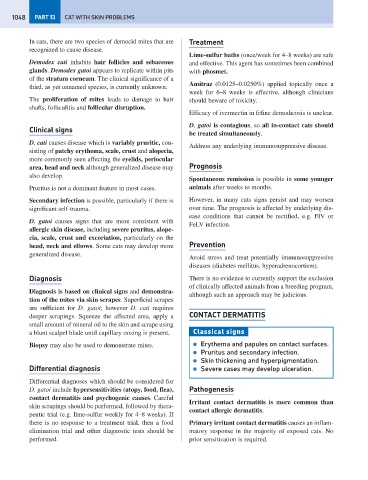Page 1056 - Problem-Based Feline Medicine
P. 1056
1048 PART 13 CAT WITH SKIN PROBLEMS
In cats, there are two species of democid mites that are Treatment
recognized to cause disease.
Lime-sulfur baths (once/week for 4–8 weeks) are safe
Demodex cati inhabits hair follicles and sebaceous and effective. This agent has sometimes been combined
glands. Demodex gatoi appears to replicate within pits with phosmet.
of the stratum corneum. The clinical significance of a
Amitraz (0.0125–0.0250%) applied topically once a
third, as yet unnamed species, is currently unknown.
week for 6–8 weeks is effective, although clinicians
The proliferation of mites leads to damage to hair should beware of toxicity.
shafts, folliculitis and follicular disruption.
Efficacy of ivermectin in feline demodicosis is unclear.
D. gatoi is contagious, so all in-contact cats should
Clinical signs
be treated simultaneously.
D. cati causes disease which is variably pruritic, con-
Address any underlying immunosuppressive disease.
sisting of patchy erythema, scale, crust and alopecia,
more commonly seen affecting the eyelids, periocular
area, head and neck although generalized disease may Prognosis
also develop.
Spontaneous remission is possible in some younger
Pruritus is not a dominant feature in most cases. animals after weeks to months.
Secondary infection is possible, particularly if there is However, in many cats signs persist and may worsen
significant self-trauma. over time. The prognosis is affected by underlying dis-
ease conditions that cannot be rectified, e.g. FIV or
D. gatoi causes signs that are more consistent with
FeLV infection.
allergic skin disease, including severe pruritus, alope-
cia, scale, crust and excoriation, particularly on the
head, neck and elbows. Some cats may develop more Prevention
generalized disease.
Avoid stress and treat potentially immunosuppressive
diseases (diabetes mellitus, hyperadrenocortism).
Diagnosis There is no evidence to currently support the exclusion
of clinically affected animals from a breeding program,
Diagnosis is based on clinical signs and demonstra-
although such an approach may be judicious.
tion of the mites via skin scrapes. Superficial scrapes
are sufficient for D. gatoi; however D. cati requires
deeper scrapings. Squeeze the affected area, apply a CONTACT DERMATITIS
small amount of mineral oil to the skin and scrape using
a blunt scalpel blade until capillary oozing is present. Classical signs
Biopsy may also be used to demonstrate mites. ● Erythema and papules on contact surfaces.
● Pruritus and secondary infection.
● Skin thickening and hyperpigmentation.
Differential diagnosis ● Severe cases may develop ulceration.
Differential diagnoses which should be considered for
D. gatoi include hypersensitivities (atopy, food, flea), Pathogenesis
contact dermatitis and psychogenic causes. Careful
Irritant contact dermatitis is more common than
skin scrapings should be performed, followed by thera-
contact allergic dermatitis.
peutic trial (e.g. lime-sulfur weekly for 4–8 weeks). If
there is no response to a treatment trial, then a food Primary irritant contact dermatitis causes an inflam-
elimination trial and other diagnostic tests should be matory response in the majority of exposed cats. No
performed. prior sensitization is required.

